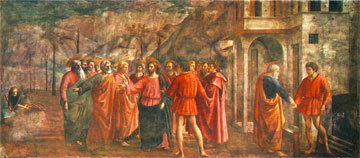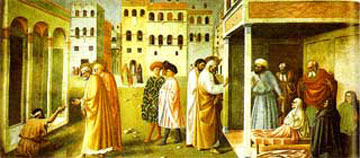Masaccio: Master of the painting art
Among the Renaissance artists of the early years of the 15th Century, one name stands supreme in the art of painting, that of Masaccio.
Masaccio was born in Florence in 1401, the son of a poor notary. He lived only twenty-seven years, dying in Rome in misery and debt in 1428, but in that short life he had accomplished a stupendous work. The friend of Ghiberti, Donatello and Brunelleschi, Masaccio was instructed by the latter in the principles of perspective and architecture, the fruits of which we see in the architectural backgrounds of many of his frescoes, and this would seem to be his one debt to antiquity.
Masaccio was probably studying in Rome about 1418. Vasari tells of two pictures of his which were to be seen in the Church of Santa Maria Maggiore; one of Our Lady with four saints, the other of Pope Liberius with the features of Martin V.
Masaccio in Florence
Masaccio returned to Florence in 1420, and three years later was commissioned to continue the series of frescoes in the Brancacci Chapel of the Carmine which had been begun by his master, Masolino, in 1422, and were finished in 1484 by Filippino Lippi.

Masaccio - Tribute Money, 1426-1427
Cappella Brancacci
Santa Maria del Carmine, Florence
The chapel is covered with frescoes adapted to fit into the high side walls, the awkward spaces about the single window, and into the narrow panels of the entrance. The attribution of frescoes is made difficult by the fact that is hard to disengage the work of Masaccio from that of Masolino. The matter is complicated further by the fact that Filippino Lippi continued the works in the chapel sixty years later, completing what was left unfinished by Masaccio.
Seven of these would seem to be by the hand of Masaccio, and the beauty and originality of his work attracted all succeeding Florentine artists to come and inspire from it, so that this Chapel has been rightly called the school of modern painting.
The Raising of Tabitha, one of the long sidewall frescoes attributed to Masolino, may be very well the point of meeting between the master and the pupil. The genius of the scholar completed and even improved the original Masolino's conception, an achievement in the concrete vision with the elimination of unnecessary detail.
In his grasp on the elemental structure of form, air and light, Masaccio is one of the supreme masters. In the group of Peter Enthroned (on the right hand side of the large composition completed by Filippino), he reaches the perfection of the art of painting.
The Tribute Money is generally considered as the full expression of Masaccio's genius. The intent group in the centre, the emphatic importance of the noble central figure, who is with the group but you can tell is above it, the concentrated energy, restrained, yet immanent in every person, the simplicity of the drawing which is almost Greek-like, the imagination in the background, all mark the fullness of Masaccio's power. The landscape is based upon the mountain scenery near Florence, and it is profoundly felt as both nature and symbolic suggestion, in a manner only found in Leonardo da Vinci's works.

Masolino and Masaccio
Healing of the Lame and the Resurrection of Tabitha, 1425
Cappella Brancacci
Santa Maria del Carmine, Florence
As sheer art, Masaccio's treatment of the nude, his powers of foreshortening, the pose and modeling of his figures were new things; to which must be added his talent for simplification; for eliminating all but the essential, his feeling for beauty and proportion, and above all his sense of the dignity of the human form.
In his works, Florentine artists recognised the soul of their endeavours, their ideals, and they all went to his frescoes, to sketch and copy, among them Raphael and Michelangelo. It is thus a normal result to find Masaccio's figures reappear in later works, as in the Expulsion by Michelangelo, and that of Raphael.
Nature was Masaccio's teacher. Vasari says that "he perceived that painting is nothing but counterfeiting all the things of Nature vividly and simply." It is justice done when Leonardo da Vinci himself writes in his literary notes about the decline of Florentine painting after Giotto, until Masaccio "showed by his perfect works how those who take for their standard anyone but nature the mistress of all masters weary themselves in vain."
Masaccio made an epoch in the history of painting; the curious thing was that twenty years were to elapse before, as Lanzi puts it, those Renaissance artists who imitated him succeeded in arriving where he, who imitated no one, had already arrived.